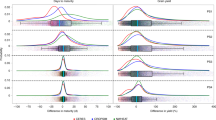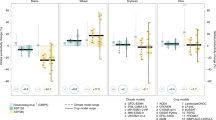Abstract
Understanding sources of uncertainty in climate–crop modelling is critical for informing adaptation strategies for cropping systems. An understanding of the major sources of uncertainty in yield change is needed to develop strategies to reduce the total uncertainty. Here, we simulated rain-fed wheat cropping at four representative locations in China and Australia using eight crop models, 32 global climate models (GCMs) and two climate downscaling methods, to investigate sources of uncertainty in yield response to climate change. We partitioned the total uncertainty into sources caused by GCMs, crop models, climate scenarios and the interactions between these three. Generally, the contributions to uncertainty were broadly similar in the two downscaling methods. The dominant source of uncertainty is GCMs in Australia, whereas in China it is crop models. This difference is largely due to uncertainty in GCM-projected future rainfall change across locations. Our findings highlight the site-specific sources of uncertainty, which should be one step towards understanding uncertainties for more robust climate–crop modelling.
This is a preview of subscription content, access via your institution
Access options
Access Nature and 54 other Nature Portfolio journals
Get Nature+, our best-value online-access subscription
$29.99 / 30 days
cancel any time
Subscribe to this journal
Receive 12 digital issues and online access to articles
$119.00 per year
only $9.92 per issue
Buy this article
- Purchase on Springer Link
- Instant access to full article PDF
Prices may be subject to local taxes which are calculated during checkout





Similar content being viewed by others
Data availability
Code availability
The detailed R code for data processing and illustration is available from the corresponding author upon reasonable request. The executable source code and pseudo-code of the crop models used in this study are available from their respective owners, as listed in Supplementary Table 2.
References
Lobell, D. B. et al. The critical role of extreme heat for maize production in the United States. Nat. Clim. Change 3, 497–501 (2013).
Trnka, M. et al. Adverse weather conditions for European wheat production will become more frequent with climate change. Nature Clim. Change 4, 637–643 (2014).
Wang, B., Liu, D. L., Asseng, S., Macadam, I. & Yu, Q. Modelling wheat yield change under CO2 increase, heat and water stress in relation to plant available water capacity in eastern Australia. Eur. J. Agron. 90, 152–161 (2017).
Asseng, S. et al. Uncertainty in simulating wheat yields under climate change. Nat. Clim. Change 3, 827–832 (2013).
Wang, B. et al. Australian wheat production expected to decrease by the late 21st century. Glob. Change Biol. 24, 2403–2415 (2018).
Bassu, S. et al. How do various maize crop models vary in their responses to climate change factors? Glob. Change Biol. 20, 2301–2320 (2014).
Sun, S., Yang, X., Lin, X., Sassenrath, G. F. & Li, K. Climate-smart management can further improve winter wheat yield in China. Agric. Syst. 162, 10–18 (2018).
Wang, B. et al. Designing wheat ideotypes to cope with future changing climate in South-Eastern Australia. Agric. Syst. 170, 9–18 (2019).
Chen, J., Brissette, F. P., Chaumont, D. & Braun, M. Performance and uncertainty evaluation of empirical downscaling methods in quantifying the climate change impacts on hydrology over two North American river basins. J. Hydrol. 479, 200–214 (2013).
Liu, D. L. & Zuo, H. Statistical downscaling of daily climate variables for climate change impact assessment over New South Wales, Australia. Clim. Change 115, 629–666 (2012).
Lehmann, J. & Rillig, M. Distinguishing variability from uncertainty. Nat. Clim. Change 4, 153 (2014).
Tao, F. et al. Contribution of crop model structure, parameters and climate projections to uncertainty in climate change impact assessments. Glob. Change Biol. 24, 1291–1307 (2018).
Hernandez-Ochoa, I. M. et al. Climate change impact on Mexico wheat production. Agric. Forest Meteorol. 263, 373–387 (2018).
Ashraf Vaghefi, S. et al. Regionalization and parameterization of a hydrologic model significantly affect the cascade of uncertainty in climate-impact projections. Clim. Dyn. 53, 2861–2886 (2019).
Chen, J., Brissette, F. P., Poulin, A. & Leconte, R. Overall uncertainty study of the hydrological impacts of climate change for a Canadian watershed. Water Resour. Res. 47, W12509 (2011).
Gao, J. et al. Uncertainty of hydrologic processes caused by bias-corrected CMIP5 climate change projections with alternative historical data sources. J. Hydrol. 568, 551–561 (2019).
Liu, D. L. et al. Effects of different climate downscaling methods on the assessment of climate change impacts on wheat cropping systems. Clim. Change 144, 687–701 (2017).
Macadam, I., Argüeso, D., Evans, J. P., Liu, D. L. & Pitman, A. J. The effect of bias correction and climate model resolution on wheat simulations forced with a regional climate model ensemble. Int. J. Climatol. 36, 4577–4591 (2016).
Breiman, L. Random forests. Mach. Learn. 45, 5–32 (2001).
Climate Change in Australia Information for Australia’s Natural Resource Management Regions Technical Report (CSIRO and Bureau of Meteorology, 2015).
Wu, S.-Y., Wu, Y. & Wen, J. Future changes in precipitation characteristics in China. Int. J. Climatol. 39, 3558–3573 (2019).
Ruan, H. et al. Future climate change projects positive impacts on sugarcane productivity in southern China. Eur. J. Agron. 96, 108–119 (2018).
Zhang, H. et al. Climate-associated rice yield change in the Northeast China Plain: a simulation analysis based on CMIP5 multi-model ensemble projection. Sci. Total Environ. 666, 126–138 (2019).
Tao, F. et al. Why do crop models diverge substantially in climate impact projections? A comprehensive analysis based on eight barley crop models. Agric. Forest Meteorol. 281, 107851 (2020).
Webber, H. et al. Canopy temperature for simulation of heat stress in irrigated wheat in a semi-arid environment: a multi-model comparison. Field Crops Res. 202, 21–35 (2017).
Ahmed, M. et al. Novel multimodel ensemble approach to evaluate the sole effect of elevated CO2 on winter wheat productivity. Sci. Rep. 9, 7813 (2019).
O’Leary, G. J. et al. Response of wheat growth, grain yield and water use to elevated CO2 under a Free-Air CO2 Enrichment (FACE) experiment and modelling in a semi-arid environment. Global Change Biol. 21, 2670–2686 (2015).
Folberth, C. et al. Uncertainty in soil data can outweigh climate impact signals in global crop yield simulations. Nat. Commun. 7, 11872 (2016).
Wang, B., Liu, D. L., Waters, C. & Yu, Q. Quantifying sources of uncertainty in projected wheat yield changes under climate change in eastern Australia. Clim. Change 151, 259–273 (2018).
Wallach, D. et al. How well do crop models predict phenology, with emphasis on the effect of calibration? Preprint at bioRxiv https://doi.org/10.1101/708578 (2019).
Xiong, W. et al. Different uncertainty distribution between high and low latitudes in modelling warming impacts on wheat. Nat. Food 1, 63–69 (2020).
Knutti, R., Masson, D. & Gettelman, A. Climate model genealogy: generation CMIP5 and how we got there. Geophys. Res. Lett. 40, 1194–1199 (2013).
Pennell, C. & Reichler, T. On the effective number of climate models. J. Clim. 24, 2358–2367 (2011).
Angstrom, A. Solar and terrestrial radiation. Report to the International Commission for Solar Research on actinometric investigations of solar and atmospheric radiation. Q. J. R. Meteorol. Soc. 50, 121–126 (1924).
Jeffrey, S. J., Carter, J. O., Moodie, K. B. & Beswick, A. R. Using spatial interpolation to construct a comprehensive archive of Australian climate data. Environ. Model. Softw. 16, 309–330 (2001).
Wijngaard, J. B., Klein Tank, A. M. G. & Können, G. P. Homogeneity of 20th century European daily temperature and precipitation series. Int. J. Climatol. 23, 679–692 (2003).
Wang, B. et al. Using multi-model ensembles of CMIP5 global climate models to reproduce observed monthly rainfall and temperature with machine learning methods in Australia. Int. J. Climatol. 38, 4891–4902 (2018).
Richardson, C. W. & Wright, D. A. WGEN: A Model for Generating Daily Weather Variables (United States Agricultural Research Service, 1984).
He, L. et al. Multi-model ensemble projections of future extreme heat stress on rice across southern China. Theor. Appl. Climatol. 133, 1107–1118 (2017).
Feng, P. et al. Projected changes in drought across the wheat belt of southeastern Australia using a downscaled climate ensemble. Int. J. Climatol. 39, 1041–1053 (2019).
Liu, D. L. et al. Crop residue incorporation can mitigate negative climate change impacts on crop yield and improve water use efficiency in a semiarid environment. Eur. J. Agron. 85, 51–68 (2017).
Wang, B. et al. Multi-model ensemble projections of future extreme temperature change using a statistical downscaling method in south eastern Australia. Clim. Change 138, 85–98 (2016).
Moss, R. H. et al. The next generation of scenarios for climate change research and assessment. Nature 463, 747–756 (2010).
Taylor, K. E., Stouffer, R. J. & Meehl, G. A. An overview of CMIP5 and the experiment design. Bull. Am. Meteorol. Soc. 93, 485–498 (2012).
Morim, J. et al. Robustness and uncertainties in global multivariate wind–wave climate projections. Nat. Clim. Change 9, 711–718 (2019).
Acknowledgements
This work was part of a study investigating the impacts of and adaptation to our changing climate in Australia and China. Funding support for G.J.O. was provided by the Victorian Department of Jobs, Precincts and Regions and the Grains Research and Development Corporation through the Australian Grains FACE project and Modelling Grain Quality project (CMI 105498). We acknowledge the Program for Climate Model Diagnosis and Intercomparison (PCMDI) and the WCRP’s Working Group on Coupled Modelling (WGCM) for their roles in making available the WCRP CMIP5 multi-model dataset. We thank R. Lines-Kelly for editing to improve an earlier version of this manuscript.
Author information
Authors and Affiliations
Contributions
B.W. and D.L.L. designed the research. B.W., T.J. and D.X. collected crop data. P.F. and D.L.L. generated change factor and statistical downscaling climate data, respectively. P.F., B.W., D.L.L., G.J.O. and T.J. ran crop models. B.W. and P.F. drew the figures. B.W. wrote the draft manuscript. P.F., D.L.L., I.M., G.J.O., S.A., C.W., A.C., H.R., J.H. and Q.Y. contributed to writing the manuscript.
Corresponding authors
Ethics declarations
Competing interests
The authors declare no competing interests.
Additional information
Publisher’s note Springer Nature remains neutral with regard to jurisdictional claims in published maps and institutional affiliations.
Supplementary information
Supplementary Information
Supplementary Figs. 1–4, Tables 1–17, Methods and References.
Rights and permissions
About this article
Cite this article
Wang, B., Feng, P., Liu, D.L. et al. Sources of uncertainty for wheat yield projections under future climate are site-specific. Nat Food 1, 720–728 (2020). https://doi.org/10.1038/s43016-020-00181-w
Received:
Accepted:
Published:
Issue Date:
DOI: https://doi.org/10.1038/s43016-020-00181-w
This article is cited by
-
Diversifying crop rotation increases food production, reduces net greenhouse gas emissions and improves soil health
Nature Communications (2024)
-
Increasing Topdressing Ratio of Nitrogen Fertilizer Improves Grain Yield and Nitrogen Use Efficiency of Winter Wheat Under Winter and Spring Night-Warming
Journal of Soil Science and Plant Nutrition (2024)
-
Multi-model ensemble of CMIP6 projections for future extreme climate changes in wheat production regions of China
Climate Dynamics (2024)
-
Mathematical optimization of frost resistant crop production to ensure food supply during a nuclear winter catastrophe
Scientific Reports (2023)
-
Nutrient use efficiency has decreased in southwest China since 2009 with increasing risk of nutrient excess
Communications Earth & Environment (2023)



